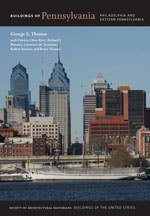
In the twentieth century, Bethlehem expanded north and west from its core, filling farmland with residential and small-scale commercial districts. On its way to meet the Lehigh River, Monocacy Creek wanders through this landscape, largely hidden in its narrow cut behind older houses and along a railroad spur track. But it is celebrated at one bridge crossing. Here at a site anchored by a nineteenth-century gristmill, a WPA project channels the stream into the rustic centerpiece of a linear park running perpendicular to the road. Two large open-air picnic pavilions line the east bank, their hipped roofs supported on square-cut stone pillars. One features a great fireplace, its stone backing forming an entire wall. At the end of the park two similar elevated pavilions flank a six-foot-high weir. A pedestrian suspension bridge supported by castellated stone piers crosses over the creek. The park and its appurtenances are reminders of how pleasing and useful were so many of the WPA's small-scale projects.










